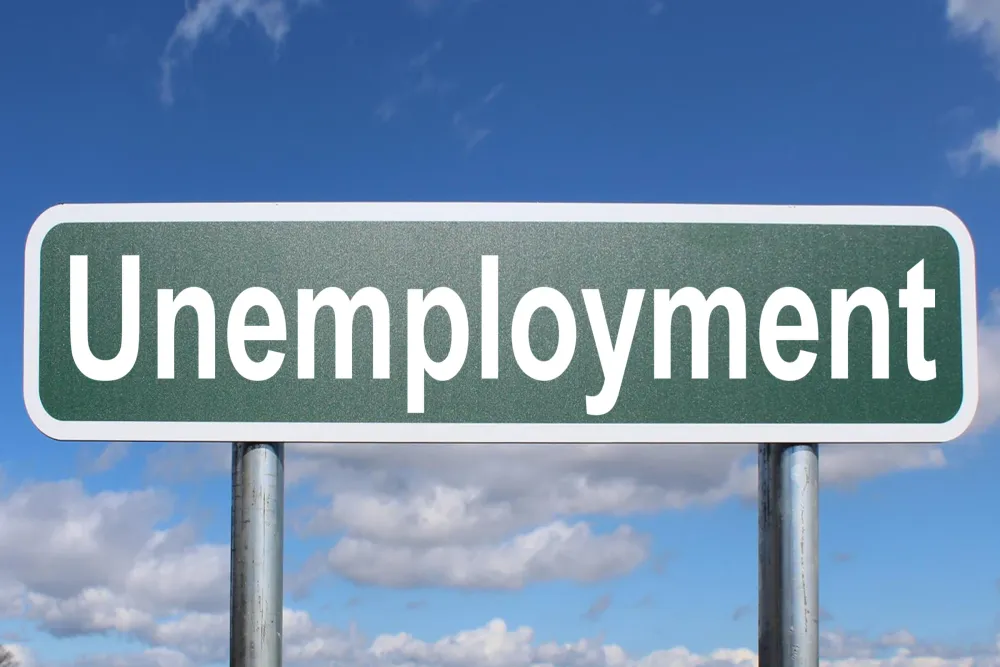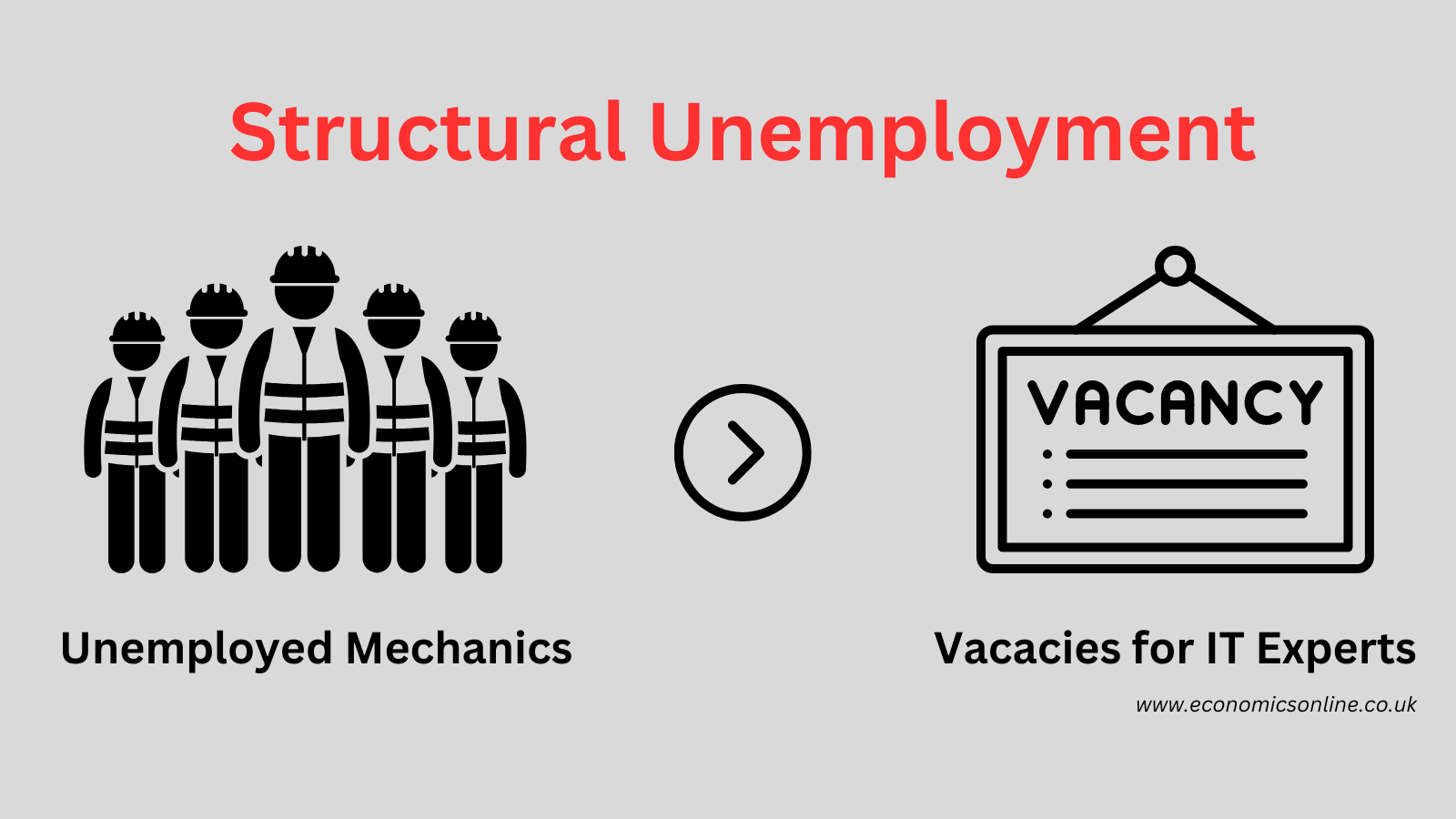
An image showing unemployment sign.
Structural Unemployment
What is Structural Unemployment?
Structural unemployment is a type of unemployment that occurs due to a mismatch between the skills and qualifications of available workers and the requirements of available vacant jobs. It means that the available jobless workers in the labour market do not have the necessary skills to meet the requirements of vacant jobs. It is created because of decline in some industries, technological advancements, changes in consumer demand, and shifts in the global economy.
Structural unemployment can contribute significantly in determining the overall unemployment rate of the country.

Structural Unemployment vs. Other types of Unemployment
Structural unemployment differs from cyclical unemployment, which is caused by low demand for goods and services in the economy during an economic recession. This can be indicated by the decreasing real GDP in the business cycle.
Structural unemployment is also different from frictional unemployment, which results from workers leaving or losing jobs and taking time to find alternative jobs. Structural unemployment is long-term unemployment, while frictional unemployment is short-term.
Causes of Structural Unemployment
Structural unemployment can be caused by various factors, some of which are explained below:
Decline of Some Industries
One reason for structural unemployment is the decline in some industries. Some industries may decline due to changes in consumer preferences or technological advancements. Some examples of structural unemployment due to this reason are given here. The first example is the decline of the coal industry in many countries, which has resulted in job losses for workers who were previously employed in the sector. Another example is the rise of automation due to the availability of new technologies, which has led to a decrease in the demand for manual labour. Due to technological changes, the skills of redundant workers from declining industries do not match the job requirements in the growing industries, which leads to structural unemployment.
Changes in Consumer Demand
Another cause of structural unemployment is the changes in consumer demand. For example, the shift of consumers towards e-commerce has led to a decrease in the demand for brick-and-mortar retail workers.
Shifts in the Global Economy
Changes in the global economy, such as outsourcing and offshoring, can also create a mismatch between the skills and qualifications of workers and the needs of employers. For example, the outsourcing of manufacturing jobs to other countries has led to a decrease in the demand for certain types of manufacturing workers in the UK.
Disadvantages of Structural Unemployment
Structural unemployment can have many negative effects on individuals, firms, society, the government, and the economy as a whole, including:
Loss of Income
Structural unemployment can result in a loss of income for individuals who are unable to find work that matches their skills and qualifications. These workers are unable to earn money to meet financial needs. This increases the chances of malnutrition, illness, mental stress, and loss of self-esteem, leading to depression.
Labour Shortage
Structural unemployment can lead to a reduced pool of suitable workers for firms, as there may be fewer workers available in the labor force with the necessary skills to meet the requirements of jobs. This shortage in the labor market can make it difficult for firms to find suitable workers, leading to higher recruitment costs, a higher wage rate to be offered, and a reduced ability for firms to grow.
Social Problems
Structural unemployment means that the unemployed people are unable to find jobs matching their skills. They are unable to earn money and hence may fall into illegal activities. This can lead to social problems, such as increased crime rates and social unrest.
Increased Government Spending
Structural unemployment can increase in government spending on social welfare programs, such as unemployment benefits and job training programs to support those workers who have become unemployed. This increase in government spending has opportunity cost because the same money can be spent elsewhere such as healthcare.
Lower Economic Growth
Unemployment is a waste of human resource. Due to unemployment, economy will operate below its production possibility frontier due to less number of workers who are able to contribute to the economy, leading to inefficiency. This means that the economy is producing less than its production potential leading to lower economic growth and standard of living in the country.
Solutions to Structural Unemployment
There are several potential solutions to structural unemployment, which are explained below:
Education and Training
Education and training programs can help unemployed individuals acquire the different skills and qualifications needed for available jobs. Governments and firms can invest in these trainings to help employees develop the necessary skills to match the requirements of available jobs. Due to this training and education, workers will be able to find jobs in new industries.
Entrepreneurship Programs
Entrepreneurship programs can help jobless individuals to start their own businesses and create new jobs. Government can also help them by providing low cost loans on easy terms.
Mobility of Labour
One reason of structural unemployment is the geographical immobility of labour. Jobless workers may be in one city and the available jobs matching their skills may be in another city. Government can invest money on building infrastructure and transport systems in order to improve geographical mobility of workers. Relocating workers may have some problems, but helping them relocate will reduce structural unemployment.
Conclusion
Structural unemployment occurs due to the mismatch between workers' skills and the requirements of vacant jobs. This type of unemployment has many negative effects on the economy. Hence, it is very important for government to address this issue to ensure that workers have access to employment and that the economy can continue to grow.


